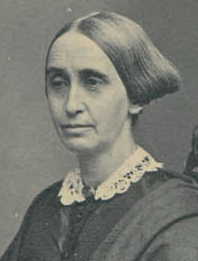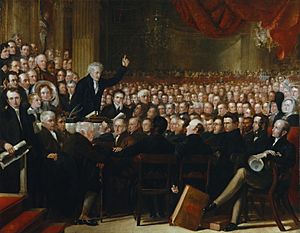Mary Grew facts for kids
Quick facts for kids
Mary Grew
|
|
|---|---|

c. 1863
|
|
| Born | September 1, 1813 |
| Died | October 10, 1896 (aged 83) |
| Occupation | Abolitionist; suffragist |
| Parent(s) | Henry Grew and Kate Merrow |
| Relatives | Margaret Jones Burleigh (life partner) |
Mary Grew (September 1, 1813 – October 10, 1896) was an American abolitionist and suffragist. She worked for equal rights for almost the entire 19th century. Mary was a leader of the Philadelphia Female Anti-Slavery Society and the Pennsylvania Anti-Slavery Society.
She was one of eight women chosen to attend the World Anti-Slavery Convention in 1840. However, these women were not allowed to be full delegates. Mary Grew was also a writer and journalist. She wrote for newspapers that fought against slavery. She also wrote about the work of abolitionists in Philadelphia for over 30 years. Mary was a talented public speaker, which was unusual for women at that time. People said her life story was like a history of all the reform movements in Pennsylvania for 50 years.
Contents
Early Life and Education
Mary Grew was born in Hartford, Connecticut, in 1813. Her father, Henry Grew, was a religious writer who also worked to end slavery. Mary's mother was Kate Merrow, her father's third wife. Mary was very close to her older half-sister, Susan.
Mary went to Catharine Beecher’s Hartford Female Seminary. This school gave her the best education a girl could get in the 1820s. In 1834, her family moved to Philadelphia. There, Mary joined the new Philadelphia Female Anti-Slavery Society.
Working to End Slavery
Mary Grew was a strong abolitionist, meaning she believed slavery should be ended completely and immediately. She worked closely with William Lloyd Garrison, another famous abolitionist. In Pennsylvania, groups fighting slavery included both Black and white people, and both men and women. This was different from some other groups in the country.
Mary was a leader in both the Pennsylvania Anti-Slavery Society and the Philadelphia Female Anti-Slavery Society. The Female Anti-Slavery Society met often. They held an annual craft fair to raise money for both organizations.
The 1840 World Anti-Slavery Convention
Because of their important work, four leaders from the Philadelphia Female Anti-Slavery Society were chosen as delegates for Pennsylvania. They were Mary Grew, Sarah Pugh, Elizabeth Neall, and Abby Kimber. They were all white, but their society included African American women as members and founders. Lucretia Mott, a very important abolitionist from Philadelphia, also went to London. She was a delegate for the national American Anti-Slavery Society.
Mary Grew traveled to England with her father, Henry Grew, who was also a delegate. They sailed on the ship Roscoe in May 1840. Other delegates on the ship included the other women from the Philadelphia Female Anti-Slavery Society, James and Lucretia Mott, and others.
Before and during the convention, there was a big argument about whether women delegates should be allowed to participate. Mary's father actually agreed with the British organizers. He spoke in favor of men having the right to exclude women, even though this meant his own daughter would be excluded. In the end, women were allowed to attend the convention, but they could not speak. They also had to sit in a separate area.
Speaking and Writing for the Cause
Back in Philadelphia, Mary Grew continued to be an excellent writer and speaker. She often spoke alongside Sojourner Truth, a famous abolitionist and women's rights activist. They spoke together before and after the Civil War. For example, in 1853, Grew and Truth spoke at a meeting of the Female Anti-Slavery Society. They also spoke at the first meeting of the Pennsylvania Woman Suffrage Association in December 1869.
Mary Grew was one of the first women to work in newspapers, like Mary Ann Shadd Cary. She edited the Pennsylvania Freeman, which was Pennsylvania’s main abolitionist newspaper. After this paper joined with the National Anti-Slavery Standard in 1854, Mary wrote for the National as a reporter from Philadelphia.
One of Mary Grew’s lasting contributions was her detailed record of the Philadelphia Female Anti-Slavery Society's work. She wrote the group’s annual report every year. These reports were sometimes 100 pages long and were published as small books. In 1870, when the group closed down, Mary wrote a review of its 37 years of work.
A letter exchange between Mary Grew and Maria Weston Chapman helped create the first Anti-Slavery Convention of American Women in New York in 1837. The next year, the second Women's Anti-Slavery Convention met in Philadelphia. It was held in the brand new Pennsylvania Hall. While the women met, an angry crowd gathered outside. They were upset that women were speaking in public and that Black and white people were meeting together. The mob then burned the Hall to the ground.
Working for Women's Right to Vote
The unfair treatment Mary Grew, Lucretia Mott, and other women delegates faced in 1840 helped start the Seneca Falls Convention. This meeting in 1848 was a very important event for women's rights. Mary Grew was not at Seneca Falls, but she strongly believed in women's equality.
In the same year, Mary Grew worked to convince the Pennsylvania legislature to pass the Married Women’s Property Act. This law would give married women more control over their own property.
After the Civil War, the 15th Amendment was about to be passed. This amendment gave Black men the right to vote. Mary Grew then focused more on women’s suffrage, which is the right for women to vote. When suffragists disagreed about women being left out of the 15th Amendment, Grew joined Lucy Stone and the American Woman Suffrage Association. Mary Grew was the first president of the Pennsylvania Woman Suffrage Association. She led the group for 23 years.
Mary Grew was frustrated with people who asked why women needed to vote. At a convention in 1871, she asked, “What is woman going to do with the ballot? I don’t know; I don’t care; and it is of no consequence. Their right to the ballot does not rest on the way in which they vote.” She meant that women had a right to vote simply because they were citizens, not because of how they would vote.
Mary Grew's many achievements did not change her father's mind about women's equality. In 1854, the fifth yearly National Women's Rights Convention was held in Philadelphia. Mary was on the planning committee. Her father demanded to speak and ended up debating Lucretia Mott. During this debate, he praised the idea that men were superior and had more authority.
In November 1870, Mary Grew led the first anniversary meeting of the Pennsylvania Woman Suffrage Association. The famous poet John Greenleaf Whittier was expected to attend. Whittier sent his apologies and a poem he wrote as a tribute to Mary. The poem was called "How Mary Grew."
How Mary Grew
With wisdom far beyond her years
And graver than her wondering peers ...
She dared the scornful laugh of men,
The hounding mob, the slanderer’s pen.
She did the work she found to do,—
A Christian heroine, Mary Grew!
The freed slave thanks her; blessing comes
To her from women’s weary homes;
The wronged and erring find in her
Their censor mild and comforter.
The world were safe if but a few
Could grow in grace as Mary Grew!
So, New Year’s Eve, I sit and say,
By this low wood-fire, ashen gray;
Just wishing, as the night shuts down,
That I could hear in Boston town,
In pleasant Chestnut Avenue,
From her own lips, how Mary Grew!
And hear her graceful hostess tell
The silver-voicëd oracle
Who lately through her parlors spoke
As through Dodona’s sacred oak,
A wiser truth than any told
By Sappho’s lips of ruddy gold,—
The way to make the world anew,
Is just to grow—as Mary Grew!
Personal Life
Mary Grew and her close friend, Margaret Jones Burleigh, lived together for most of their adult lives. They became inseparable in their mid-30s. Their group of abolitionist friends included Cyrus M. Burleigh, who co-edited the Philadelphia Freeman with Mary. In 1855, when Cyrus was very ill, Margaret Jones married him.
He died one month later. Margaret took care of his affairs, and then she and Mary went on a trip to New England. Within six months, they were signing their letters “Mary & Margaret.” They continued to live together for the rest of their lives.
When Margaret died in 1891, Mary received messages of sympathy, just like a widow would. When Mary died in Philadelphia five years later, on October 10, 1896, her eulogy described their bond. It said they had grown "like two noble trees, side by side from youth to age." It added that when one was gone, the other could never quite feel the same way about life again. They are buried next to each other at Woodlands Cemetery in Philadelphia.
Mary Grew became a member of the Unitarian church. She was sometimes allowed to preach there. She also preached at Free-will Baptists, Methodists, and Congregational churches in northern New England. She was one of the people who helped start the New Century Club in Philadelphia.


